If you want to build a bigger and stronger bicep, then you must add barbell curls to your arm workout routine.
Why are barbell curls so vital? For generations, bodybuilders and strength athletes have relied on barbell curls to build impressive arms. This isn’t just tradition – it’s backed by results. They are a highly effective way to target the biceps, brachii, and brachialis muscles.
Barbell curls are known for isolating the biceps. This exercise promotes muscle growth, definition, and increased arm strength.
There are many variations of barber curl that you can add to your workout routine, and each has its own unique benefits.
- In standard barbell curl, you will place approximately equal emphasis on both bicep heads.
- A narrow grip will emphasize the long head and build the peak of your biceps.
- A wide grip will emphasize the short head and give your biceps more width.
- The Preacher Curl exercise isolates the biceps and minimizes the use of swinging or cheating movements.
- Reverse grip barbell curl helps to target the brachialis muscle more intensely.

- Barbell Curl Muscles Worked
- How To Do Barbell Curl
- Proper Form And Technique
- Set, Reps And Frequency For Barbell Curl
- Barbell Bicep Curls Variations
- 1. Wide Grip Barbell Curl
- 2. Close Grip Barbell Curl
- 3. Barbell Preacher Curl
- 4. Barbell Spider Curl
- 5. Barbell Drag Curl
- 6. EZ Bar Curl
- Add Barbell Curl Into Your Workout Routine
- 1. Bicep-Focused Workout Routine
- 2. Pull Workout Routine
- 3. Full-Body Workout Routine
Barbell Curl Muscles Worked
The barbell curl, primarily works the biceps brachii. A handful of other muscles worked or play the role of stabilizer muscles, including your brachialis, brachioradialis and forearm muscles.
The barbell curl involves several synergist muscles, including oblique and core muscles.
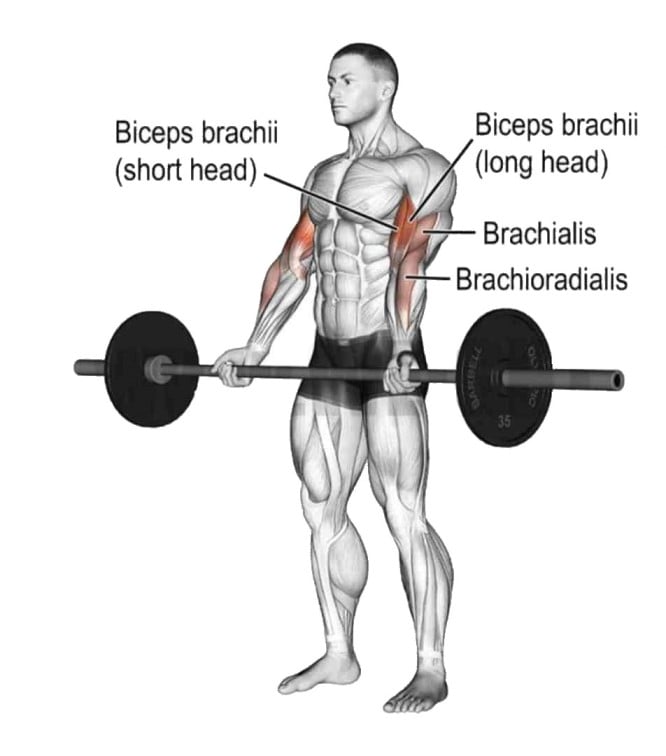
- The Biceps is a large, thick muscle of the upper arm. It has two heads: short (inner) and long (outer).
- The brachialis is a muscle located underneath the biceps brachii. It is primarily responsible for elbow flexion.
- The brachioradialis is a forearm muscle that runs along the outer side of the forearm. It assists elbow flexion and plays a secondary role during the barbell curl.
How To Do Barbell Curl
- Stand with your feet shoulder-width apart and your knees slightly bent.
- Grab the barbell with an underhand grip (palms facing up) at shoulder-width or slightly narrower.
- Let the bar hang naturally in front of your thighs, with your arms fully extended but not locked out.
- Keep your elbows close to your sides.
- Engage your core and maintain an upright posture with your chest lifted and shoulders back.
- Exhale and slowly curl the barbell upwards towards your chest.
- Keep curling until your forearms are almost vertical and the barbell is close to your chest.
- Inhale and slowly lower the barbell back down to the starting position.
- That’s one rep! Now do it again, champ.
- Do 8–12 repetitions and 3-4 sets
Proper Form And Technique
- Avoid using excessive momentum or swinging your body to lift the weight. Focus on using your biceps to control the movement.
- Don’t underestimate the pause at the top of your curl, and take a moment to squeeze your bicep when you get there.
- A slow controlled descent will increase time under tension, leading to more effective sets and less risk of injury.
- Ensure that your elbows are kept close to your sides with your knees slightly bent and your hands gripped tightly to the bar.
- You should focus on the contraction of the biceps at the top of the movement.
- Always select a weight that gives you full control of your body.
- Incorporate proper warm-ups, rest, and nutrition into your exercise program.
- Rest for 24 to 48 hours before training the same muscle groups to allow sufficient recovery.
- Perform this exercise in a slow, controlled manner for best results.
- Don’t go heavy. Choose a lighter weight and focus on perfecting your form.
- Once you’ve mastered proper form with a lighter weight, you can increase the weight and reps. However, it’s important to do so safely and gradually. Start by increasing the weight by 5-10% and reducing your reps to 6-8.
Set, Reps And Frequency For Barbell Curl
The number of reps you should do depends on your goals, whether they are to increase strength or build muscle mass and endurance.
- For muscle growth, it is best to do for around 6–12 reps per set.
- For strength, around 3–8 reps per set are recommended.
- To build Muscle Endurance, do 15-20+ reps per set.
Here are some general guidelines for the barbell curl exercise, including sets, reps, and frequency, to build muscle mass
| Fitness Level | Sets | Reps | Frequency |
|---|---|---|---|
| Beginner | 2-3 | 8-10 | 1 times per week |
| Intermediate | 3-4 | 8-12 | 2–3 times per week |
| Advanced | 4-5 | 8-15 | 2–3 times per week |
Barbell Bicep Curls Variations
There are several variations of barbell curls that can target different areas of your biceps and forearms.
1. Wide Grip Barbell Curl
Wide grip barbell curl is one of the best variations of barbell bicep curl to build a short head of bicep. When doing it, please ensure your hands are wider than your shoulders.
It is often designed with a large volume per set and a low weight. It is typically performed during the latter portion of a workout session to prevent premature fatiguing of the biceps.
The wide-grip barbell curl has several unique benefits over other types of bicep curls.
- First, it helps prevent plateaus and stimulate muscle growth through muscle confusion.
- Second, it emphasizes the inner head of the biceps, which can help give them a fuller look.
- Third, it can help to improve your grip strength.
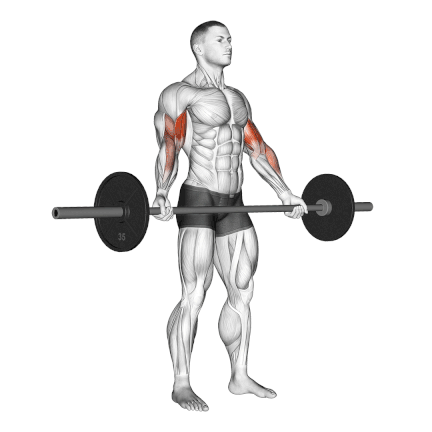
How To Do
- Stand upright with your feet shoulder-width apart.
- Grip the barbell with an underhand grip, with your hands wider than shoulder-width apart.
- Keep your back straight and your core engaged.
- Bend your elbows and curl the barbell up to shoulder level.
- Squeeze your biceps at the top of the movement.
- Then, slowly lower the barbell back down to the starting position.
2. Close Grip Barbell Curl
The close grip barbell curl is a highly recognizable biceps exercise that builds the outer biceps (long head). It also activates the brachialis muscle. This little guy is a secret weapon for adding serious size to your arms.
When you do this, you should place your hands closer together on the bar, typically a few inches apart, instead of gripping it with your hands shoulder-width apart.
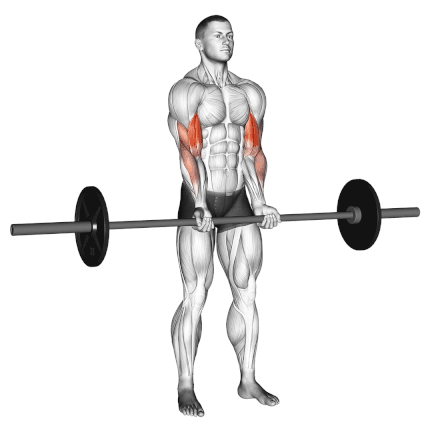
How To Do
- Stand with your feet shoulder-width apart and knees slightly bent.
- Grasp the barbell with an underhand grip at a narrower distance than shoulder width,
- Curl the bar up towards your shoulders, squeezing your biceps hard at the top. This time, your elbows will naturally flare out a bit, which is fine.
- Don’t just let gravity do the work. Lower that bar slowly and feel your biceps stretching.
- Do 3–4 sets of 8–12 reps. Always focus on Quality over quantity.
3. Barbell Preacher Curl
The barbell preacher curl is a fantastic exercise for targeting your biceps in a controlled and effective manner. It is performed on a preacher bench, which supports the arms and isolates the biceps by taking the momentum (swinging) out of the equation.
The preacher curl allows for a full range of motion, especially in the lower part of the curl where your arms are fully extended.

How To Do
- Adjust the preacher curl bench so that your armpits/upper arm comfortably rest on the top of the pad
- Sit on a preacher’s bench with your elbows resting on the preacher’s pad.
- Now, grasp the barbell with an underhand grip (palms facing up) at shoulder-width or slightly wider.
- Curl the bar to the barbell upward and get maximum contraction at the top.
- Slowly lower the barbell back down, resisting the weight. Fully extend your arms, but don’t lock out your elbows completely.
4. Barbell Spider Curl
If you’re looking for a way to get more creative with your barbell curl exercises, why not try the Barbell spider curl?
Barbell spider curls train your biceps in a shortened (that is, maximally contracted) muscle position. This results in a powerful muscle pump that makes your arms appear more vascular and can lead to significant hypertrophy.
Spider bicep curls are typically done with a barbell. However, you can also use an EZ bar or dumbbell.

How To Do
- Adjust the bench to an incline and level to a 45-degree angle. Lean against the bench so that your chest is supported.
- Stand on the balls of your feet and keep them about shoulder width apart for stability.
- Let your arms hang in front of your torso. From here, prepare a barbell or set it up before you.
- Slowly curl the barbell toward your shoulders and squeeze your biceps forcefully.
- Hold the contraction momentarily, then slowly lower the bar under control until your elbows are fully extended.
5. Barbell Drag Curl
The barbell drag curl forces your biceps to work in a way they’re not used to. Instead of curling the bar up in an arc like a traditional curl, you’re dragging it up your body while keeping your elbows back.
This unique path puts your biceps under constant tension and gives the bicep a crazy pump and serious growth stimulus.
The drag curl forces you to keep a strict form. There’s no room for swinging the bar or using momentum, so your biceps are doing all the work. It’s a good way to focus on quality contractions and keep your ego at bay.
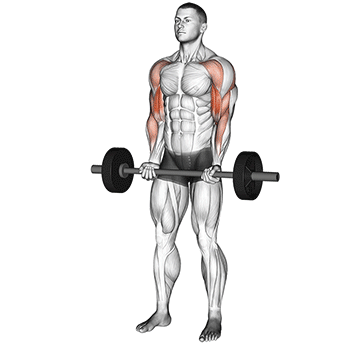
How To Do
- Stand with your feet shoulder-width apart, your knees slightly bent, and your abs drawn in.
- Grasp the barbell with an underhand grip (palms facing up) and hands about shoulder-width apart.
- Let the bar hang naturally in front of your thighs.
- Now, here’s where it gets interesting. Instead of curling the bar straight up, think about pulling your elbows back and dragging the bar up your body.
- Squeeze your biceps hard at the top and slowly return to the starting position.
6. EZ Bar Curl
If you’ve ever felt a little wrist discomfort during regular barbell curls, or you’re just looking for a way to target your biceps from a slightly different angle, the EZ bar is your new best friend.
The EZ bar’s semi-supinated grip (palms facing slightly inward) puts your wrists in a more natural, neutral position. This can dramatically reduce strain compared to the straight bar.
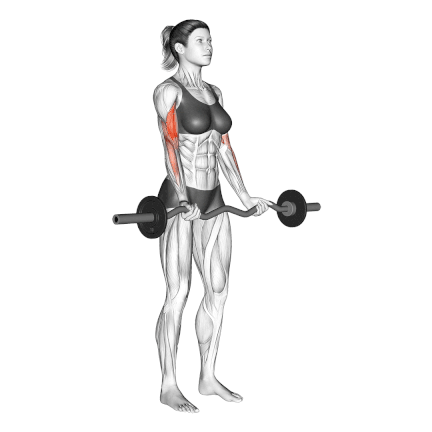
Note: In the study conducted, they found that the EZ barbell curl showed the highest overall electromyography (EMG) activity in the biceps brachii (BB) and brachioradialis (BR) muscles compared to the dumbbell curl (DC) and barbell curl (BC) variants.
Add Barbell Curl Into Your Workout Routine
You can incorporate barbell curls into your workout routine in various ways. Here are some options:
- As a standalone exercise: Do 3–4 sets of 8–12 reps.
- As part of a bicep workout: Do 3–4 sets of 8–12 reps along with other bicep exercises like the dumbbell bicep curl and hammer curl.
- As part of a full-body workout: Do 3–4 sets of 8–12 reps and other compound exercises like squats, deadlifts, and bench presses.
1. Bicep-Focused Workout Routine
| Exercise | Sets | Reps |
|---|---|---|
| Barbell Curl | 3-4 | 8-12 |
| Hammer Curl | 3 | 10-12 |
| Preacher Curl | 3 | 8-10 |
| Concentration Curl | 4 | 8-12 |
| Cable Curl | 3 | 8-12 |
2. Pull Workout Routine
| Exercise | Sets | Reps |
|---|---|---|
| Pull-Ups | 3 | 8-10 |
| Plank | 3 | 8-12 |
| Lat Pulldowns | 3 | 10-12 |
| Barbell Curl | 3 | 8-12 |
| Dumbbell Shrugs | 3 | 8-12 |
3. Full-Body Workout Routine
| Exercise | Sets | Reps |
|---|---|---|
| Squats | 3-4 | 8-10 |
| Bench Press | 4 | 6-8 |
| Deadlifts | 3 | 8-12 |
| Barbell Curl | 3 | 8-10 |
| Overhead Press | 4 | 8-10 |
| Lunges | 3 | 8-12 |
| Plank | 3 | 30 sec |
References
- Marcolin G, Panizzolo FA, Petrone N, Moro T, Grigoletto D, Piccolo D, Paoli A. Differences in electromyographic activity of biceps brachii and brachioradialis while performing three variants of curl. PeerJ. 2018 Jul 13;6:e5165.
- Staudenmann D, Taube W. 2015. Brachialis muscle activity can be assessed with surface electromyography. Journal of Electromyography and Kinesiology 25(2):199-204

Manish is a NASM-certified fitness and nutrition coach with over 10 years of experience in weight lifting and fat loss fitness coaching. He specializes in gym-based training and has a lot of knowledge about exercise, lifting technique, biomechanics, and more.
Through “Fit Life Regime,” he generously shares the insights he’s gained over a decade in the field. His goal is to equip others with the knowledge to start their own fitness journey.
